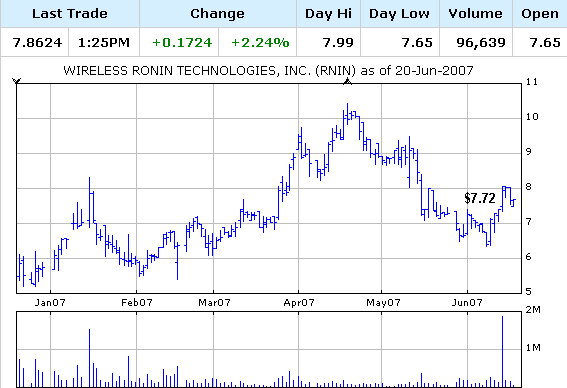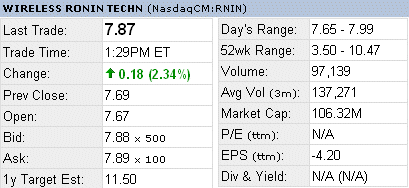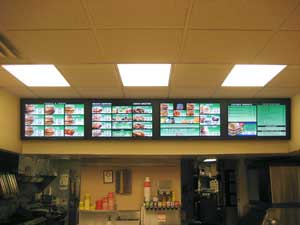Digital Signs are those electronic signs you see in casinos, stores, kiosks and ball parks, to name a few areas.
Unlike traditional signs, these signs are generated using computer software.
They can change continuously and provide animated scenes, plain old text, video and images which are good
enough to appear like the real thing.
These signs can be networked together and controlled using using a single PC or work station.
The advantage of these over regular signs is that you don't have to hire a crew to put up a new bill board or paint
over an old one. The display can be changed instantly.
From what I have read, digital signage is more viewed of as an oddity than a main ingredient for a marketing plan.
This is from a Blog a couple years old and I think is is worth reading:
|
Retail Television Networks Coming of Age Author: Bill Gerba on 2005-02-18 12:31:17 I came across two articles in the news today about in-store television networks that shed a bit of light on the possible business models and ROI potential of in-store advertising. The first article is actually some PR from satellite content network provider IMTV about a project that they're rolling out in Russia. The company intends to invest $10M to deploy a network of advertising screens across the region, starting with their first deployments in Ramenka Company. While not tremendously exciting (to me, anyway) in and of itself, what caught my eye were the specifics of their content formatting: "Every area will have its own timing of ads broadcasting. For instance, Food and Non-Food areas will have [a] 7-minute cycle which consists of 20 advertising clips, each 15 seconds long. The time cycle in BWS area is 3,5 minutes, in the Cash desk area - 6 minutes, in Halls and Corridors area - 3 minutes. The customer stays a little longer in the Restaurants and Cafes area that is why the time cycle for commercial[s] here is 15 minutes." So their recipe for success is perpetually looping short-duration commercials, presumably for items found in the store. They clearly have given some thought to total cycle length, factoring in the amount of time that a person is likely to linger in a particular area of the store.......... The next article
comes from the New Jersey Star Ledger, which claims that CompUSA has
had excellent success with their own in-store TV network. "In the stores that included advertising, sales of the advertised products averaged 29 percent more than in the other stores" (my emphasis added).......... So what does all of
this mean for us in the digital signage industry? In-store digital advertising is no longer looked upon as a quirky experiment or pet project; it's now a bonafide component of a retailer's overall display marketing strategy. Even stalwart VARs and integrators are starting to take notice. Because the market is still so young, it's hard to get solid data about the efficacy of in-store digital signage. But the initial results that I've seen (and posted about, of course) indicate that a well-implemented signage network can perform the nearly-miraculous retail trifecta of lowering costs, improving customer satisfaction, and driving sales. |
There are lots of companies out there now involved the business. I went looking for a company newly listed, close
to making a profit, had cheap stock and shares actually held by a few mutual funds. I also wanted a company listed
on a major exchange.
I did not want to see a lot of press on the stock either in print media or on blogs and message boards.
I was looking for that little undiscovered gem which could facilitate moving up the retirement date.
Finding such a stock was tougher than I thought. It was a manual effort.
And the Winner is:
Wireless Ronin Technologies (RNIN) - Nasdaq Went public December, 2006


It is pretty cheap and has some pretty good volume for a small company.

RNIN is actually held by a few mutual funds.
This was the only commentary I could find about the fund from a fund manager.
From and interview with Craig Hodges, of the Hodges Fund (HDPMX)
I did manage to find a pretty good editorial about the CEO and the company:
|
By Neal St. Anthony, Star Tribune Last update: June 02, 2007 – 2:50 PM Jeff Mack is back running a public company. Mack, 53, was the driver behind a 1990s-vintage car-finance outfit that targeted tarnished-creditcustomers. The firm, Olympic Financial, ballooned to a market value of $1 billion for a time, winning Mack accolades. That was before he left the company in 1996 in a dispute with the board over its future direction, amid financial and management issues. Olympic was sold for about $200 million to a bigger finance company in 1999. By then,
Mack & Company were burning through millions in investor money
on something that eventually Mack is not the first entrepreneur to crash and burn. Or to rise from the ashes. Since 2003, he has been CEO of a company that raised $16.7 million from public investors called Wireless Ronin, an interesting outfit that provides "dynamic digital signage solutions" at more than 275 venues ranging from Best Buy stores to the Las Vegas Convention and Visitors Authority and the Minneapolis Convention Center. Mack declined to be interviewed for this column. A spokesman said Ronin executives are barred from speaking to the media at this time because they're out selling what they hope will be an additional $20 million or so in stock, on top of a $16 million initial public offering last November..................... Ronin (ticker symbol: RNIN) is a fairly small Eden Prairie-based company with big aspirations. It probably isn't the place for faint-of-heart investors or your kid's college fund. The company, founded in 2000, lost $14.8 million on revenue of $3.15 million in 2006. But investors in these kinds of stocks aren't buying the past. They're betting on a profitable future. The company has told investors that it expects revenue of $15 million to $20 million this year. The stock price has ranged from as low as $3.50 per share late last year to as high as $9.05 in the first quarter. It changed hands for about $6.75 in recent days. Ronin used the money it raised in November to pay down debt and invest in the business. Of the 4 million shares it hopes to sell within the next few weeks in its secondary offering, 1 million are being sold by an existing shareholder, the Spirit Lake Indian tribe. Essentially, Ronin believes it's got some pretty nifty software that will allow retailers and the hospital industry to deliver touch-screen display technology that will prove good for retailers, resorts and others who want to inform and influence customers. The Ronin prospectus, which also details numerous risks for investors, says that the use of digital signage is expected to grow from $102.5 million in 2004 to $3.7 billion within a few years. Current investors include Perkins Capital Management of Wayzata, which specializes in small growth companies and Heartland Advisors of Milwaukee. The underwriters of the stock include Michael Moe's Think Equity investment bank of San Francisco and Feltl & Co. of Minneapolis. Mack was paid about $275,000 in cash last year and received 291,666 stock options that vest over the next several years. His chief financial officer is John Witham, who worked for Mack at Olympic and later was CFO for a few years at Metris Companies, the credit card company that was sold last year. |

This is an example from a fast food restaurant.
How will the company do? Will it Fly?
Who knows. I suspect it might fly a little higher than GTEL and their Stratellites.
Assess the risk, speculate on the reward and do your own DD.
